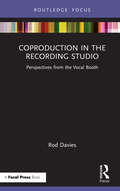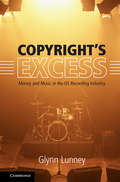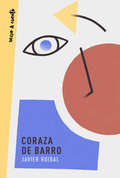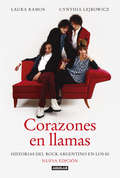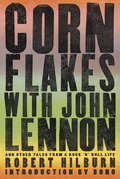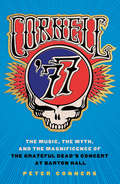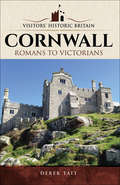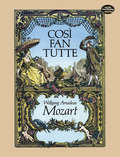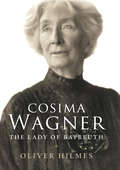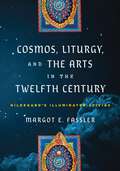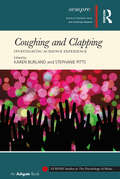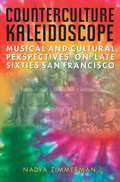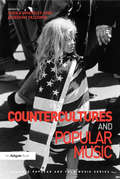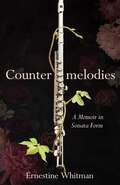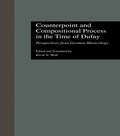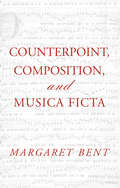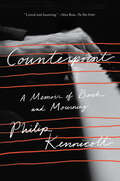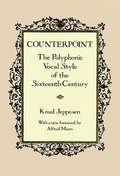- Table View
- List View
Copland: 1900 Through 1942
by Aaron Copland Vivian PerlisThis memoir begins with Copland's Brooklyn childhood and takes us through his years in Paris, the creation of his early works, and his arrival at Tanglewood. Rich with remembrances from Leonard Bernstein, Virgil Thomson, and Nadia Boulanger, as well as a trove of letters, photographs, and scores from Copland's collection.
Coproduction in the Recording Studio: Perspectives from the Vocal Booth
by Rod DaviesCoproduction in the Recording Studio: Perspectives from the Vocal Booth details how recording studio environments affect performance in the vocal booth. Drawing on interviews with professional session singers, this book considers sociocultural and sociotechnical theory, the modern home studio space, as well as isolation and self-recording in light of the COVID-19 pandemic. This is cutting-edge reading for advanced undergraduates, scholars and professionals working in the disciplines of recording studio production, vocal performance, audio engineering and music technology.
Copy Cat (School Gyrls #2)
by Jacque NimbleJacque is struggling with school work. If she doesn't make good grades, she'll have to leave the school -- and her friends!
Copyright’s Excess: Money and Music in the U. S. Recording Industry
by Glynn LunneyFor more than 200 years, copyright in the United States has rested on a simple premise: more copyright will lead to more money for copyright owners, and more money will lead to more original works of authorship. In this important, illuminating book, Glynn Lunney tests that premise by tracking the rise and fall of the sound recording copyright from 1961 to 2015, along with the associated rise and fall in sales of recorded music. Far from supporting copyright’s fundamental premise, the empirical evidence finds the exact opposite relationship: more revenue led to fewer and lower-quality hit songs. Lunney’s breakthrough research shows that what copyright does is vastly increase the earnings of our most popular artists and songs Doing so reduced their productivity. At the same time, copyright did very little to increase the earnings of, and hence increase the productivity of, artists at the margins. The net result: more revenue was associated with the release of fewer hit songs. This book should be read by anyone interested in how copyright operates in the real world.
Coraza de barro
by Javier RuibalJavier Ruibal, uno de los cantautores más admirados y lúcidos de nuestra época, reciente ganador del Goya a la mejor canción, nos regala su primer poemario. «Guardaste del daño memoria indeleblepor toda defensa, coraza de barro,carne, desgarro y escalofrío». Una disección, un autorretrato de filias y fobias, un pequeño puñado de miedos, unas pocas esperanzas y alguna manía poco saludable. Eso guarda cuidadosamente este libro. Un conjunto de poemas en los que Javier Ruibal, uno de los artistas más valorados y talentosos de nuestro panorama musical, se desnuda para ordenarse por dentro. Clasificados en una suerte de metáfora de ritmos y fórmulas musicales, el autor nos regala poemas libres, décimas y haikus que hablan de amor, del paso del tiempo y del encuentro con uno mismo en la vida y en el arte, dejando también un pequeño lugar para el humor y la sorna.
Corazones en llamas: Historias del Rock Argentino en los 80 (Nueva Edición)
by Laura Ramos Cynthia LejbowiczLas crónicas de la maravillosa década del 80 en el rock nacional escritas por Ramos y Lejcowicz en un libro emblemático, fresco y subjetivo, que cuenta las historias fundacionales no solo de músicos, sino de artistas, escenarios y público de una generación que cambió el rumbo en la cultura y la sociedad argentinas. Reedición de uno de los libros emblemáticos de los '80. Anécdotas del rock como nunca habían sido contadas. Las historias de una década que marcó un cambio social, cultural y musical en Argentina y se proyectó al resto de Latinoamérica, contada con la frescura y la pasión de dos mujeres: Laura Ramos y Cynthia Lejbowicz. Charly García, Fito Páez, Gustavo Cerati, Fabiana Cantilo, Hilda Lizarazu, Andrés Calamaro, Federico Moura, Luca Prodan, el Indio Solari, entre otros, protagonizan estas crónicas que se desarrollan en casas, embajadas, bares, pubs, salas de ensayo, giras, fiestas y hoteles, y registran una época maravillosa, donde todo estaba sucediendo y por suceder.
Corn Flakes with John Lennon: And Other Tales from a Rock 'n' Roll Life
by Robert HilburnRobert Hilburn's storied career as a rock critic has allowed him a behind-the-scenes look at the lives of some of the most iconic figures of our time. He was the only music critic to visit Folsom Prison with Johnny Cash. He met John Lennon during his lost weekend period in Los Angeles and they became friends. Bob Dylan granted him his only interviews during his "born-again" period and the occasion of his 50th birthday. Michael Jackson invited Hilburn to watch cartoons with him in his bedroom. When Springsteen took to playing only old hits, Hilburn scolded him for turning his legendary concerts into oldies revues, and Springsteen changed his set list. In this totally unique account of the symbiotic relationship between critic and musical artist, Hilburn reflects on the ways in which he has changed and been changed by the subjects he's covered; Bono weighs in with an introduction about how Hilburn's criticism influenced and altered his own development as a musician. Corn Flakes with John Lennon is more than about one man's adventures in rock and roll: It's the gripping and untold story of how popular music reshapes the way we think about the world and helps to define the modern American character.
Cornell '77: The Music, the Myth, and the Magnificence of the Grateful Dead's Concert at Barton Hall
by Peter ConnersOn May 8, 1977, at Barton Hall, on the Cornell University campus, in front of 8,500 eager fans, the Grateful Dead played a show so significant that the Library of Congress inducted it into the National Recording Registry. The band had just released Terrapin Station and was still finding its feet after an extended hiatus. In 1977, the Grateful Dead reached a musical peak, and their East Coast spring tour featured an exceptional string of performances, including the one at Cornell. Many Deadheads claim that the quality of the live recording of the show made by Betty Cantor-Jackson (a member of the crew) elevated its importance. Once those recordings—referred to as "Betty Boards"—began to circulate among Deadheads, the reputation of the Cornell ’77 show grew exponentially. With time the show at Barton Hall acquired legendary status in the community of Deadheads and audiophiles.Rooted in dozens of interviews—including a conversation with Betty Cantor-Jackson about her recording—and accompanied by a dazzling selection of never-before-seen concert photographs, Cornell ’77 is about far more than just a single Grateful Dead concert. It is a social and cultural history of one of America’s most enduring and iconic musical acts, their devoted fans, and a group of Cornell students whose passion for music drove them to bring the Dead to Barton Hall. Peter Conners has intimate knowledge of the fan culture surrounding the Dead, and his expertise brings the show to life. He leads readers through a song-by-song analysis of the performance, from "New Minglewood Blues" to "One More Saturday Night," and conveys why, forty years later, Cornell ’77 is still considered a touchstone in the history of the band.As Conners notes in his Prologue: "You will hear from Deadheads who went to the show. You will hear from non-Deadhead Cornell graduates who were responsible for putting on the show in the first place. You will hear from record executives, academics, scholars, Dead family members, tapers, traders, and trolls. You will hear from those who still live the Grateful Dead every day. You will hear from those who would rather keep their Grateful Dead passions private for reasons both personal and professional. You will hear stories about the early days of being a Deadhead and what it was like to attend, and perhaps record, those early shows, including Cornell ’77."
Cornwall: Romans to Victorians (Visitors' Historic Britain)
by Derek TaitCornwall has a rich and diverse history stretching from prehistoric times to the Norman Conquest and beyond, including the turbulent Tudor period, the English Civil War and the First and Second World Wars. Neolithic settlements and Bronze Age dwellings have been found at Carn Brea in Redruth and Rough Tour at Camelford, and many standing stones are scattered across the land. An ancient forest lies beneath the waters between Marazion and the legendary St Michael's Mount, which dates back thousands of years.The area is steeped in legend and Tintagel has mythical connections with King Arthur, although the present castle was probably constructed by Richard, Earl of Cornwall (brother to King Henry III), who owned the site from about 1234. Tales of the Devil, giants, minions and other imps abound in the county.Many of Daphne Du Maurier's books are set in Cornwall including Jamaica Inn and Frenchman's Creek. Virginia Woolf's novel To the Lighthouse was based on holidays at St Ives, Cornwall, where her family took her every summer until 1895. The lighthouse at Godrevy gives inspiration to the title.Various battles and conflicts as well as the diverse and fascinating history of Cornwall are all featured within the pages of this book, which also includes many of the well-known people who have greatly influenced the area over the years.
Corporate Rock Sucks: The Rise and Fall of SST Records
by Jim RulandA no-holds-barred narrative history of the iconic label that brought the world Black Flag, Hüsker Dü, Sonic Youth, Soundgarden, and more, by the co-author of Do What You Want and My Damage.Greg Ginn started SST Records in the sleepy beach town of Hermosa Beach, CA, to supply ham radio enthusiasts with tuners and transmitters. But when Ginn wanted to launch his band, Black Flag, no one was willing to take them on. Determined to bring his music to the masses, Ginn turned SST into a record label. On the back of Black Flag&’s relentless touring, guerilla marketing, and refusal to back down, SST became the sound of the underground.In Corporate Rock Sucks, music journalist Jim Ruland relays the unvarnished story of SST Records, from its remarkable rise in notoriety to its infamous downfall. With records by Black Flag, Minutemen, Hüsker Dü, Bad Brains, Sonic Youth, Dinosaur Jr, Screaming Trees, Soundgarden, and scores of obscure yet influential bands, SST was the most popular indie label by the mid-80s--until a tsunami of legal jeopardy, financial peril, and dysfunctional management brought the empire tumbling down. Throughout this investigative deep-dive, Ruland leads readers through SST&’s tumultuous history and epic catalog.Featuring never-before-seen interviews with the label's former employees, as well as musicians, managers, producers, photographers, video directors, and label heads, Corporate Rock Sucks presents a definitive narrative history of the &’80s punk and alternative rock scenes, and shows how the music industry was changed forever.
Cosi fan Tutte in Full Score (Dover Music Scores)
by Wolfgang Amadeus MozartTranslated from the Italian, Cosi fan tutte means "That's how all women act"; the libretto, the last of three Lorenzo da Ponte wrote for Mozart, concerns the behavior of women, particularly the behavior of young women in the throes of romantic love. Are they fickle? Are their affections mutable? Their virtue flexible? In Cosi fan tutte, Mozartand Da Ponte answer with resounding affirmatives.In the nearly 200 years since it was first performed at the Burgtheater in Vienna, Cosi fan tutte has waxed and waned and waxed again in popularity. The music, with its richness of melody, harmony, and texture, and its perfection of form, has never been considered less than brilliant. The libretto, however, has not been as well received as evidenced by attempts in the 19th century to "improve" it, making it more possible to the overly decorous sensibilities of the Victorians.In examining the reaction of 19th-century opera goers, the noted British composer, conductor, and musicologist Spike Hughes laments, "The opera must indeed have seemed to them sadly untypical of the Divine Mozart, who not only seemed to enjoy this trivialities, not to say indecencies, of an exquisitely constructed libretto, but even went so far as to squander an unending stream of lovely music on worthless characters and contemptible situations."The "worthless" characters are Ferrando and Guglielmo, two Italian army officers in love with two Neapolitan sisters, Fiodiligi and Dorabella. The "contemptible" situation is a wager and the comedy of deception that ensues: bragging of their ladies' fidelity, the two officers are challenged by a sage but cynical Don Alfonso who declares, "The faithfulness of woman is like the phoenix: everybody has heard about it, but nobody has ever actually seen it."In the 20th century Cosi fan tutte has once again secured its rightful and prestigious place among the world's great operas. This volume, containing the full score with Italian and German text, is reproduced from one of the most complete, accurate, and scholarly editions available. It also contains a new translation of the German editors' frontmatter and critical commentary, which includes a review of dubious passages and text problems. Beautifully and clearly engraved, this modestly priced edition of Cosi fan tutte will be welcomed by musicians, students, and all opera lovers.
Cosima Wagner: The Lady of Bayreuth
by Oliver HilmesIn this meticulously researched book, Oliver Hilmes paints a fascinating and revealing picture of the extraordinary Cosima Wagner--illegitimate daughter of Franz Liszt, wife of the conductor Hans von Bülow, then mistress and subsequently wife of Richard Wagner. After Wagner's death in 1883 Cosima played a crucial role in the promulgation and politicization of his works, assuming control of the Bayreuth Festival and transforming it into a shrine to German nationalism. The High Priestess of the Wagnerian cult, Cosima lived on for almost fifty years, crafting the image of Richard Wagner through her organizational ability and ideological tenacity. The first book to make use of the available documentation at Bayreuth, this biography explores the achievements of this remarkable and obsessive woman while illuminating a still-hidden chapter of European cultural history.
Cosmic Music: Musical Keys to the Interpretation of Reality
by Joscelyn GodwinThe idea that the universe is created out of sound or music (and therefore is music) is a very ancient one. In this book, Joscelyn Godwin brings together three contemporary German thinkers who exemplify this tradition in its modern variants: Marius Schneider, Rudolf Haase, and Hans Erhard Lauer. The selections draw on ancient Indian sources and mythology; Kepler's Platonic vision of a musical, geometric universe; and the evolution of the tone systems of music. While every music lover senses the power and truth that reside in music, very few actually approach music as a path to cosmic knowledge. Godwin takes literally Beethoven's assertion that "Music is a higher revelation than all wisdom or philosophy." Godwin writes, ". . .to penetrate the mysteries of music is to prepare for initiation into those fathomless mysteries of man and cosmos."
Cosmos, Liturgy, and the Arts in the Twelfth Century: Hildegard's Illuminated "Scivias" (The Middle Ages Series)
by Margot E. FasslerIn Cosmos, Liturgy, and the Arts in the Twelfth Century, Margot E. Fassler takes readers into the rich, complex world of Hildegard of Bingen’s Scivias (meaning “Know the ways”) to explore how medieval thinkers understood and imagined the universe. Hildegard, renowned for her contributions to theology, music, literature, and art, developed unique methods for integrating these forms of thought and expression into a complete vision of the cosmos and of the human journey. Scivias was Hildegard’s first major theological work and the only one of her writings that was both illuminated and copied by scribes from her monastery during her lifetime. It contains not just religious visions and theological commentary, but also a shortened version of Hildegard’s play Ordo virtutum (“Play of the virtues”), plus the texts of fourteen musical compositions.These elements of Scivias, Fassler contends, form a coherent whole demonstrating how Hildegard used theology and the liturgical arts to lead and to teach the nuns of her community. Hildegard’s visual and sonic images unfold slowly and deliberately, opening up varied paths of knowing. Hildegard and her nuns adapted forms of singing that they believed to be crucial to the reform of the Church in their day and central to the ongoing turning of the heavens and to the nature of time itself. Hildegard’s vision of the universe is a “Cosmic Egg,” as described in Scivias, filled with strife and striving, and at its center unfolds the epic drama of every human soul, embodied through sound and singing. Though Hildegard’s view of the cosmos is far removed from modern understanding, Fassler’s analysis reveals how this dynamic cosmological framework from the Middle Ages resonates with contemporary thinking in surprising ways, and underscores the vitality of the arts as embodied modes of theological expression and knowledge.
Coughing and Clapping: Investigating Audience Experience (SEMPRE Studies in The Psychology of Music)
by Karen Burland Stephanie PittsCoughing and Clapping: Investigating Audience Experience explores the processes and experiences of attending live music events from the initial decision to attend through to audience responses and memories of a performance after it has happened. The book brings together international researchers who consider the experience of being an audience member from a range of theoretical and empirical perspectives. Whether enjoying a drink at a jazz gig, tweeting at a pop concert or suppressing a cough at a classical recital, audience experience is affected by motivation, performance quality, social atmosphere and group and personal identity. Drawing on the implications of these experiences and attitudes, the authors consider the question of what makes an audience, and argue convincingly for the practical and academic value of that question.
Counterculture Kaleidoscope
by Nadya ZimmermanForty years after the fact, 1960s counterculture---personified by hippies, protest, and the Summer of Love---basks in a nostalgic glow in the popular imagination as a turning point in modern American history and the end of the age of innocence. Yet, while the era has come to be synonymous with rebellion and opposition, its truth is much more complex. In a bold reconsideration of the late sixties San Francisco counterculture movement, Counterculture Kaleidoscope takes a close look at the cultural and musical practices of that era. Addressing the conventional wisdom that the movement was grounded in rebellion and opposition, the book exposes two myths: first, that the counterculture was an organized social and political movement of progressives with a shared agenda who opposed the mainstream (dubbed "hippies"); and second, that the counterculture was an innocent entity hijacked by commercialism and transformed over time into a vehicle of so-called "hip consumerism." Seeking an alternative to the now common narrative, Nadya Zimmerman examines primary source material including music, artwork, popular literature, personal narratives, and firsthand historical accounts. She reveals that the San Francisco counterculture wasn't interested in commitments to causes and made no association with divisive issues---that it embraced everything in general and nothing in particular.
Countercultures and Popular Music (Ashgate Popular and Folk Music Series)
by Sheila Whiteley Jedediah Sklower’Counterculture’ emerged as a term in the late 1960s and has been re-deployed in more recent decades in relation to other forms of cultural and socio-political phenomena. This volume provides an essential new academic scrutiny of the concept of ’counterculture’ and a critical examination of the period and its heritage. Recent developments in sociological theory complicate and problematise theories developed in the 1960s, with digital technology, for example, providing an impetus for new understandings of counterculture. Music played a significant part in the way that the counterculture authored space in relation to articulations of community by providing a shared sense of collective identity. Not least, the heady mixture of genres provided a socio-cultural-political backdrop for distinctive musical practices and innovations which, in relation to counterculture ideology, provided a rich experiential setting in which different groups defined their relationship both to the local and international dimensions of the movement, so providing a sense of locality, community and collective identity.
Countermelodies: A Memoir in Sonata Form
by Ernestine WhitmanOffering a uniquely musical perspective on the #MeToo experience, this is the story of a talented and fiercely determined musician—a young woman with everything to gain and, ultimately, nothing left to lose—who finds a way through despite multiple betrayals by the men in her life.Jealous of her brilliant older sister, Ernestine longs for her father&’s approval as a little girl but is never good enough. When she discovers a talent for the flute, she meets a charismatic teacher who gives her the encouragement she craves and becomes her surrogate father. After winning several competitions, she dreams of being a professional musician, but her stern father ridicules the idea and forces her to attend Emory University as a math major like her sister. Ernestine doesn&’t give up on her musical dreams, however, and halfway through college she wins the second flute chair in the Atlanta Symphony. There, she sits beside her former teacher, the principal flute. At first, she loves working with him, but after one successful season he turns on her and does everything in his power to get her fired. Devastated by her idol&’s merciless harassment, she&’s driven into a spiral of suicidal depression. As she tries to recover, her vulnerability is exploited, again and again, by the very men she turns to for help. A harrowing account of one woman&’s battle with twentieth-century misogyny, Countermelodies follows Ernestine as, through the darkness, she clings to her love for the flute and her unshakable dream of making it in the cutthroat world of classical music.
Counterpoint The Polyphonic Vocal Sixteenth Century: The Polyphonic Vocal Style Of The Sixteenth Century (classic Reprint)
by Knud JeppesenThis classic introductory text focuses on the polyphonic vocal style perfected by Palestrina. Unlike many other texts, it maintains a careful balance between theoretical and practical problems, between historical and systematic methodology. The result is an exceptionally useful resource, ideal for classroom use in teaching modal counterpoint.In Part One, Knud Jeppesen (1892–1974), the world-renowned musicologist and leading authority on Palestrina, offers a superb outline history of contrapuntal theory. He begins by exploring the beginnings of contrapuntal theory from the ninth to the fourteenth centuries. This is followed by separate discussions of each succeeding century, the styles of Palestrina and Bach, the "Palestrina Movement" after Fux, and more. The section ends with illuminating coverage of notation, the ecclesiastical modes, melody, and harmony.The second part of the book contains an extended treatment of "species" counterpoint in two, three, and four parts, as well as counterpoint in more than four parts, and specific discussions of the canon, the motet, and the Mass. Throughout, the text is generously supplied with musical examples―exercises, solutions, and illustrations, including many by the great composers.-Print ed.
Counterpoint and Compositional Process in the Time of Dufay: Perspectives from German Musicology (Criticism and Analysis of Early Music)
by Kevin N. MollDuring the 1950s and 1960s, Austro-German scholars made decisive advances in developing concepts to account for harmonic processes in late medieval music. Despite the considerable potential these ideas hold for analysis and criticism of early music, they have hitherto exerted little influence outside their countries of origin. In order to render this valuable literature more immediately accessible to English-speaking students and scholars, this book presents translations of twelve seminal articles that originally appeared during the years 1948-1967, along with a comprehensive introductory chapter detailing the evolution of competing theories and terminology.
Counterpoint, Composition and Musica Ficta (Criticism and Analysis of Early Music #Vol. 4)
by Margaret BentMusica ficta is the practice of sharpening or flattening certain notes to avoid awkward intervals in medieval and Renaissance music. This collection gathers Margaret Bent's influential writings on this controversial subject from the past 30 years, along with an extensive author's introduction discussing the current state of scholarship and responding to critics. Also includes 25 musical examples.
Counterpoint: A Memoir Of Bach And Mourning
by Philip KennicottA Pulitzer Prize–winning critic reflects on the meaning and emotional impact of a Bach masterwork. As his mother was dying, Philip Kennicott began to listen to the music of Bach obsessively. It was the only music that didn’t seem trivial or irrelevant, and it enabled him to both experience her death and remove himself from it. For him, Bach’s music held the elements of both joy and despair, life and its inevitable end. He spent the next five years trying to learn one of the composer’s greatest keyboard masterpieces, the Goldberg Variations. In Counterpoint, he recounts his efforts to rise to the challenge, and to fight through his grief by coming to terms with his memories of a difficult, complicated childhood. He describes the joys of mastering some of the piano pieces, the frustrations that plague his understanding of others, the technical challenges they pose, and the surpassing beauty of the melodies, harmonies, and counterpoint that distinguish them. While exploring Bach’s compositions he sketches a cultural history of playing the piano in the twentieth century. And he raises two questions that become increasingly interrelated, not unlike a contrapuntal passage in one of the variations itself: What does it mean to know a piece of music? What does it mean to know another human being?
Counterpoint: The Polyphonic Vocal Style of the Sixteenth Century (Dover Books on Music)
by Knud JeppesenThis classic introductory text focuses on the polyphonic vocal style perfected by Palestrina. Unlike many other texts, it maintains a careful balance between theoretical and practical problems, between historical and systematic methodology. The result is an exceptionally useful resource, ideal for classroom use in teaching modal counterpoint. In Part One, Knud Jeppesen (1892–1974), the world-renowned musicologist and leading authority on Palestrina, offers a superb outline history of contrapuntal theory. He begins by exploring the beginnings of contrapuntal theory from the ninth to the fourteenth centuries. This is followed by separate discussions of each succeeding century, the styles of Palestrina and Bach, the "Palestrina Movement" after Fux, and more. The section ends with illuminating coverage of notation, the ecclesiastical modes, melody, and harmony. The second part of the book contains an extended treatment of "species" counterpoint in two, three, and four parts, as well as counterpoint in more than four parts, and specific discussions of the canon, the motet, and the Mass. Throughout, the text is generously supplied with musical examples―exercises, solutions, and illustrations, including many by the great composers. For this edition, the distinguished scholar Alfred Mann has contributed a new foreword to Jeppesen's classic study. Now available in paperback for the first time, it will be welcomed by musicians, composers, theorists, musicologists―any student of counterpoint and the Western musical tradition.

